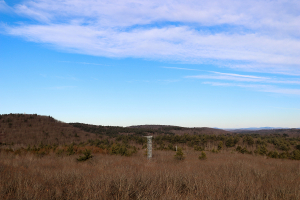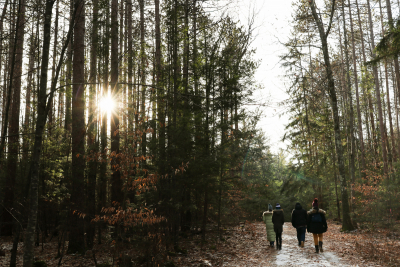You are here
The Other Harvard
Amy was a winter intern at the Harvard Forest in January 2019.
The Harvard in Cambridge smells of chaos, wet brick, and cigarette smoke. It is a never-ending whirlwind of interesting events, meals with friends, somewhat productive meetings, impending deadlines. It’s the roar of the shuttle bus, door slamming of ride-shares, honking of impatient Boston drivers as pedestrians smugly take their sweet time crossing Mass Ave. There’s skipped breakfasts, hurried lunches, late night food delivery. The church bells sounding out from Bow Street. The occasional blast of music from a cramped dorm room party. Continual pset cycles, hundreds of pages of readings, midterms that come one after another after another. Don’t get me wrong, this Harvard has its charm—you have one of the largest library systems in the world just two streets over, the mighty Charles River to laze by, and cozy cafes to help you enjoy a five-dollar coffee. But after three years, I welcomed a change of pace.

The Harvard in Petersham smells of forest and burning wood. Unsurprising, as it is a forest. What a breath of fresh air it is. In January, that air is most certainly fresh but also quite cold. Time spent at the Harvard Forest felt intentional. Tendencies to procrastinate disappeared. Books were read, planning completed, creative endeavors attempted. I felt like a better person. After a week, I began waking with the sun, alarmless, something I have never regularly accomplished before and have been unable to replicate in the weeks since returning to Cambridge.
 During the day, the work was structured enough while allowing room for creativity. We were tasked with creating the infrastructure and content for an ESRI Story Map that communicated the conservation-oriented work of colleges and universities who are members of Academics for Land Protection in New England (ALPINE). Our workdays were punctuated with biting walks through the woods, driving to Vermont for interviews, snowshoeing around Harvard Pond, and ascending a research tower with a mighty stubborn lock. I learned about New England natural history and ongoing changes to the landscapes and people. The importance of connection to place within and outside conservation contexts became clearer to me.
During the day, the work was structured enough while allowing room for creativity. We were tasked with creating the infrastructure and content for an ESRI Story Map that communicated the conservation-oriented work of colleges and universities who are members of Academics for Land Protection in New England (ALPINE). Our workdays were punctuated with biting walks through the woods, driving to Vermont for interviews, snowshoeing around Harvard Pond, and ascending a research tower with a mighty stubborn lock. I learned about New England natural history and ongoing changes to the landscapes and people. The importance of connection to place within and outside conservation contexts became clearer to me.
Over the weeks, the unfamiliar creaks of John Sanderson’s house slowly became internalized—I wondered what the house sounded like during the 1800’s. The placement of light switches, how long it took the stove to bring water to a boil, quirks of the bathroom sink faucet, the fine art of eyeballing the volume of liquid for overnight oats.

Weekly grocery runs were exciting. Cooking, too, took on a new, meditative meaning. Dinners often spanned multiple hours and were accompanied by books or a Netflix recommendation. The special place in my heart for tasty hot sauce grew even more special, and I will not easily forget the mouthfeel of cream-top, whole-milk, maple-flavored yogurt of which I deliriously consumed by the half-pound. I discovered I can, in fact, last (at least a month) on not much more than boiled (and steamed! Thanks to Angie!) vegetables, eggs, and grains. Ultimately, I arrived at the conclusion that I am (still) a terrible cook.
Our days were sinfully simple. When the weather allowed, I cherished the sunset from the front steps of Shaler Hall. At night, I could sit in bed with a book and count individual cars that passed on Route 32 below. If skies over Petersham were clear, I bundled up and heaved myself outside to photograph the stars, with wind chill of 20-below or otherwise.
I am endlessly grateful to everyone at the Harvard Forest for welcoming us. For the impromptu tours and the inner workings of lab group. For the crackling of iced-over trails and dampness of wet leaves. For your expertise, generosity, patience, and warmth. From the Harvard in the city, I’ll be thinking of the Harvard in the forest often.


